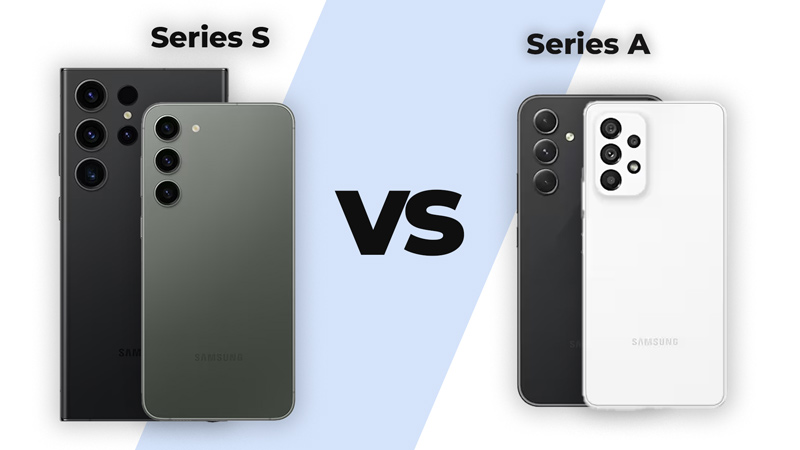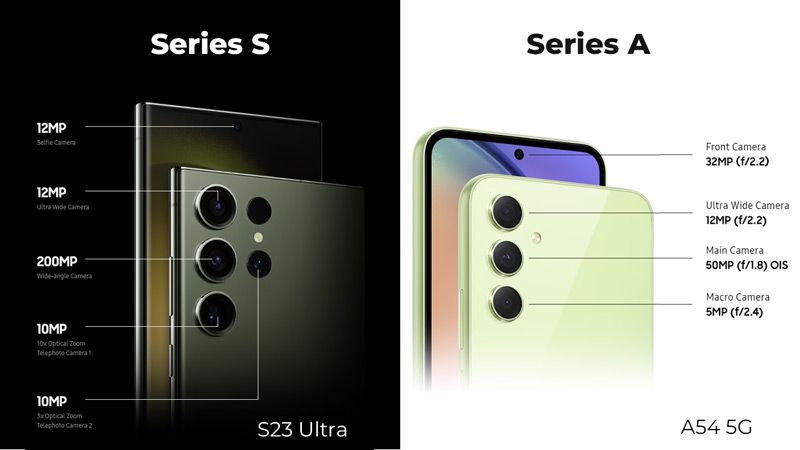
The Korean Smartphone manufacturer Samsung is all over the smartphone market with phones in almost every segment and category. Considering the wide range and devices under Samsung’s S, A, F, Z, and M Series catalog, the options are extensive and confusing. The two prime among all, Samsung Galaxy Series A and Series S are pretty close, but still distinct in significant aspects like price, features, performance, etc. In the article, learn the difference between Samsung Galaxy Series A vs Series S and which one to choose.
What is the difference between Samsung Galaxy Series A vs Series S?

The Galaxy A series is the well-regarded mid-range Samsung smartphone lineup, while the Galaxy S series is the company’s high-end, premium flagship series. Both series have exceptional features, then how do they vary? Well, Samsung has phones for every segment right from $100 to $2000, which is reflected in their market approach. It’s true, you can’t compare a mid-ranger device to a flagship. However, when it comes to the options available the price you are paying should be justified. Hence, we will be going through all the major factors one by one to understand the difference between the S series targeting the flagship market and the A series for the mid-range segment.
Flagship Series S vs Midrange Series A
The Samsung S series models are the brand’s flagship, top-of-the-order smartphone, going along with the Z and Note series. According to Samsung, “The high-end Samsung S series packs in pioneering technology, flawless design, and easy-to-use functionality”. This we actually can see while going through the specs details. While on the other hand, the A series models are made keeping the majority of users in mind. Hence, budget-friendly and are targeted at consumers who are looking for a good quality phone at a more affordable price point.
Pricing
As we go down the prices, it is obvious Samsung does cut corners wherever possible. We will notice this as we go along the article addressing most aspects that make a phone a good smartphone. Since the S lineup is targeted in the flagship segment, competing with brands like Apple, we see models breaking the $1000 barrier while the ‘A’ series is targeted towards the mid-range segment where smartphone prices reach a maximum of $500.
Build Quality
Taking the build quality into consideration, Higher-quality components, such as metal frames and glass parts, are used in the S series’ construction. When compared to the current A-series phones, the Galaxy S range often has better build quality. All models in Samsung’s S23 line have shatterproof Gorilla Glass Victus 2, promising more durability, and giving them a premium look and feel. Whereas the Galaxy A variants are constructed with plastic polycarbonate casing with a glass back sometimes.
Display
The Display has always been the highlighted part of every Samsung flagship launch. The OG Samsung Galaxy S was the first model to be launched in this series with a super AMOLED display in 2010, the company has kept that tradition intact with every model they launch in the S series. Taking a recent example, the latest Samsung Galaxy S23 models are equipped with Dynamic AMOLED 2X display panel with 2340 × 1080 (FHD+) for model S23, S23+, and 3088 × 1440 (Quad HD+) for the S23ultra.
On the other hand the prime model for the A series, the Samsung Galaxy A54 5G comes with a 1080 × 2340 (FHD+) super AMOLED display. Considering the price difference between both, you compromise features like higher resolution, curve panel, and also more bezels to work with.
Performance Difference between Series S vs Series A
Hands down, you should expect better performance from the S series models in comparison to the A series. Samsung has usually used its SoCs from the Exynos series in Europe and their Snapdragon equivalents in the US, though the S23 variants are outfitted with Qualcomm’s Snapdragon 8 Gen 2 throughout.
While Samsung often uses its own chips in midrange phones like the A series. For example, the Exynos 1380 powers the Galaxy A54. No doubt, the Exynos mid-range CPUs provide a decent mix between performance and energy consumption. And for a normal user, the performance issues aren’t noticeable until heavy multitasking or frequent heavy app usage.
Camera

Let’s get straightforward on this, one of the major aspects that separates the flagship S series from the mid-range A series. The S series has a pro-grade camera altogether comprising excellent sensors, great lenses, and powerful image and video processing. The latest Samsung Galaxy S23 is capable of recording videos up to 8k resolution. Additionally, with a more powerful primary camera and an extra lens that offers 10x optical zoom and 100x digital zoom in top-end Galaxy S Ultra, there cannot be any debate about its capabilities. While the Samsung Galaxy A series trailed behind in this category as well, using a mixture of main, ultrawide, macro, and depth sensors. Although the pictures captured are decent and impressive as well.
Software Updates
The S series phones being the top of the line and flagship of Samsung have always been prioritized and provided with 5 years of software and security updates. While recently, the A series models also promised 4 to 5 years of Software updates, to bring it a bit closer to their expensive cousin.
To conclude everything, Samsung’s strategies have always been becoming the go-to brand for smartphones, and looking at the market share, it is reflected perfectly if we see the numbers. With every launch Of the Flagship, the S series has constantly been introduced with the latest technology available at the time. Hence, the capabilities of this device are vast. This targets the Tech enthusiast, Creators, Business officials, etc. While on the other hand, the A series targets the user who wants value for money. It includes a few features, somewhat similar to the flagships, at an affordable price.
Additionally, a normal user getting an A series phone won’t feel any difference if they haven’t used any S series flagship in the past. It all comes down to the user’s requirement, an everyday user who requires basic functionality from their device including a decent camera, good display, and long-lasting battery life should go with A series models.
That’s everything covered on Samsung Galaxy Series A vs Series S. While you are here, check out similar featured articles like Which Android phone is the Best based on UI or Samsung Galaxy S22 Ultra vs iPhone 13 Pro Max.
